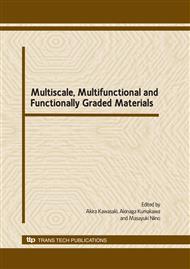p.413
p.425
p.431
p.435
p.441
p.449
p.455
p.461
p.465
Fabrication of Al-Based FGM Containing TiO2 Nano-Particles by a Centrifugal Mixed-Powder Method
Abstract:
Centrifugal method is often applied as the fabrication process of Functionally Graded Materials (FGMs). This is because that this processing method can fabricate FGMs with large size, easily. However, this processing method has a serious problem, namely it is difficult to disperse particles with small size and low wet ability with matrix. Many of powders with nano or very fine particle size often have attractive attention as functional materials. Therefore the above problem of the centrifugal method should be improved. In this study, we proposed a centrifugal mixed-powder method as novel processing technique for the fabrication of FGM containing nano-particle. On first of this processing, powder mixture of functional nano-particle and matrix material is inserted into rotating mold. After that, matrix ingot is melted in crucible and then the molten matrix is poured into the rotating mold with powder mixture, and then, powder of matrix material will be melted by the heat from molten matrix poured from crucible. Finally, an FGM ring with functional nano-particles distributed on its surface can be obtained. Using this processing method, Al-based FGM containing TiO2 nano-particles on its surface could be fabricated. TiO2 particle has approximately 500nm in diameter. From microstructural observation, it was found that TiO2 particles were successfully distributed on surface of FGM ring. Also, hardness on the surface of the FGM ring was higher than that on inner part due to the dispersion hardening.
Info:
Periodical:
Pages:
441-447
Citation:
Online since:
October 2009
Authors:
Price:
Сopyright:
© 2010 Trans Tech Publications Ltd. All Rights Reserved
Share:
Citation:


